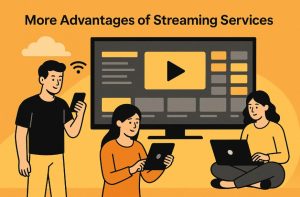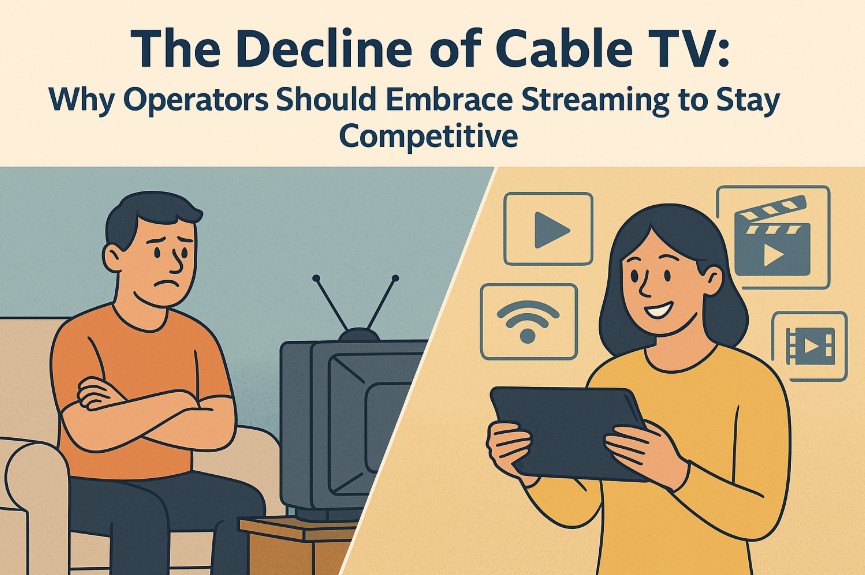Table of Contents
ToggleTraditional cable operators are losing their competitive edge by relying solely on cable TV. Despite efforts to engage audiences, these traditional methods no longer resonate with modern viewers. Younger generations, in particular, have moved away from cable TV in favor of streaming platforms. The result? Businesses that stick to outdated approaches risk becoming irrelevant in today’s digital market.
To stay competitive, video service providers need to embrace streaming. Streaming not only addresses these challenges of audience engagement but also unlocks opportunities to reach wider, more diverse audiences.
Why Cable TV is Losing Relevance?

Internet Usage is on the Rise
An increasing number of consumers are cutting the cord and turning to internet-based streaming services. People consume most of their content online and rarely engage with cable TV. For businesses and operators, adapting to this shift is essential. Adopting an IPTV or OTT platform helps companies meet their audiences where they spend the majority of their time online.
Cable TV is Expensive
Cable TV is typically more expensive than bundling a few streaming services. According to CNET’s analysis, the average cost of basic cable TV with internet is $144 per month, while premium cable with internet reaches $217.
In contrast, a combination of Netflix, Disney+, MAX, and Hulu with ads costs $33 per month, and even when adding the average internet cost of $70, the total comes to $97-$100—$44 less than basic cable.
Hence, many content providers and operators have transitioned to streaming platforms. As a result, they reduce operational costs and provide more affordable options to their customers.
Limited Content Diversity
Traditional cable TV schedules offer live broadcasts and older films which fail to engage modern viewers. Streaming platforms, on the other hand, offer a wide variety of content. Their libraries include blockbuster movies and niche series. This caters to diverse tastes. And operators can provide tailored content that resonates with specific audience segments. This enhances customer satisfaction and retention.
More Advantages of Streaming Services

Accessible on Multiple Devices
Today’s consumers are no longer tied to traditional TV sets. Instead, they rely on laptops, smartphones, and tablets for their media consumption. While cable TV limits viewers to home-based access, streaming services offer the flexibility to watch content wherever they are. It doesn’t matter whether at a café, in a queue, or on the move, they access their favorite content anytime, and anywhere.
Seeing this, traditional cable operators should immediately migrate or consider expanding their service to online video streaming. It will allow them to stay connected with their audiences across multiple touchpoints.
Improved Customer Engagement
Streaming platforms offer operators and content providers the opportunity to build stronger relationships with their customers. Delivering content accessible anytime and on any device ensures that audiences stay engaged and informed. Personalized recommendations, live streaming events, and interactive features further enhance user experience. This allows companies to drive loyalty and growth.
Scalable and Global Reach
Cable TV is often limited by geographic constraints. On the other hand, streaming platforms allow operators to reach global audiences without significant investments. Operators can scale their services to meet growing demand and tap into new markets. This ensures continuous growth and revenue opportunities.
Data-Driven Insights
Streaming platforms provide valuable analytics. Data insights help businesses understand viewer behavior, preferences, and engagement patterns. It enables companies to tailor their content strategies, optimize offerings, and enhance user experiences. With real-time data, businesses can adapt and stay responsive to changing market demands.
Cost-Effective Advertising
For businesses looking to monetize their content, streaming platforms offer wider capabilities for targeted ads that are far more effective than traditional TV commercials. Operators can leverage advanced audience segmentation to deliver personalized ads, ensuring higher ROI and better ad performance.
Conclusion
As consumer preferences continue to shift away from traditional television, operators that fail to adapt risk losing their audiences to more agile competitors. Video streaming platforms offer a scalable and innovative solution that benefits both providers and viewers.
Companies gain a modern, flexible approach to engaging their customers, while audiences enjoy the convenience of on-demand content tailored to their needs. By embracing streaming technologies, broadcasters and content owners can future-proof their operations and remain competitive in the evolving digital media landscape.




